Trends and Causes of Raw Water Quality Indicators in the Five Most Famous Lakes of Jiangsu Province, China
Abstract
1. Introduction
2. Materials and Methods
2.1. Study Area
2.2. Sampling and Determination Methods
2.3. Health Risk of Composite Assessment
2.4. Data Analysis
3. Results
3.1. Concentrations of the Eutrophication Indicator and Petroleum
3.2. Density of the Phytoplankton and the Zooplankton
3.3. Content of the Heavy Metals
3.4. Correlation Analysis of Various Water Quality Indexes and the Assessment of Health Risk
4. Discussion
5. Conclusions
Author Contributions
Funding
Institutional Review Board Statement
Informed Consent Statement
Data Availability Statement
Acknowledgments
Conflicts of Interest
References
- Yang, Y.; Yin, L.; Zhang, Q.Z. Quantity versus quality in China’s South-to-North Water Diversion Project: A system dynamics analysis. Water 2015, 7, 2142–2160. [Google Scholar] [CrossRef]
- Mueller, H.; Hamilton, D.P.; Doole, G.J. Evaluating services and damage costs of degradation of a major lake ecosystem. Ecosyst. Serv. 2016, 22, 370–380. [Google Scholar] [CrossRef]
- Zhao, H.R.; Qu, S.; Liu, Y.; Guo, S.; Zhao, H.R.; Chiu, A.C.; Liang, S.; Zou, J.P.; Ming, X. Virtual water scarcity risk in China. Resour. Conserv. Recycl. 2020, 160, 104886. [Google Scholar] [CrossRef]
- Minister of Environmental Protection of the People’s Republic of China. Report on the State of the Environment in China. 2013. Available online: https://english.mee.gov.cn/Resources/Reports/soe/soe2011/201606/P020160601591756378883.pdf (accessed on 13 January 2022).
- Krienitz, L.; Dadheech, P.K.; Fastner, J.; Kotut, K. The rise of potentially toxin producing cyanobacteria in Lake Naivasha, Great African Rift Valley, Kenya. Harmful Algae 2013, 27, 42–51. [Google Scholar] [CrossRef]
- Jiang, Y.G.; Xiao, P.; Liu, Y.; Wang, J.X.; Li, R.H. Targeted deep sequencing reveals high diversity and variable dominance of bloom-forming cyanobacteria in eutrophic lakes. Harmful Algae 2017, 64, 42–50. [Google Scholar] [CrossRef]
- Jia, T.X.; Zhang, X.Q.; Dong, R.C. Long-term spatial and temporal monitoring of cyanobacteria blooms using MODIS on google earth engine: A case study in Taihu Lake. Remote Sens. 2019, 11, 2269. [Google Scholar] [CrossRef]
- Nanjing Institute of Geography; Limnology Chinese Academy of Science. Lake in Jiangsu; Phoenix Science Press: Nanjing, China, 1982. (In Chinese) [Google Scholar]
- Du, Y.B.; Chen, Q.W.; Wang, Z.Y.; Wang, D.M.; Liu, J.J.; Chen, C.; Yang, Y.M.; Fan, Z.H. Safety evaluation of typical lake drinking water sources in Jiangsu Province. Water Resour. Prot. 2020, 36, 71–78. (In Chinese) [Google Scholar] [CrossRef]
- Chen, X.; Wang, Y.H.; Ye, C.; Zhou, W.; Cai, Z.C.; Yang, H.; Han, X. Atmospheric nitrogen deposition associated with the eutrophication of Taihu Lake. J. Chem. 2018, 2018, 4017107. [Google Scholar] [CrossRef]
- Wang, Y.; Wang, L.; Cheng, J.; He, C.; Cheng, H. Recognizing Crucial Aquatic Factors Influencing Greenhouse Gas Emissions in the Eutrophication Zone of Taihu Lake, China. Sustainability 2019, 11, 5160. [Google Scholar] [CrossRef]
- Zhang, L.; Cheng, Y.; Niu, Y.L.; Jiang, J.H. Analysis and prediction of eutrophication for advanced warning of the water quality concerns in Gaoyou Lake. Water Supply 2020, 20, 186–196. [Google Scholar] [CrossRef]
- Duan, H.T.; Cao, Z.G.; Shen, M.; Dong, L.; Xiao, Q.T. Detection of illicit sand mining and the associated environmental effects in China’s fourth largest freshwater lake using daytime and nighttime satellite images. Sci. Total Environ. 2019, 647, 606–618. [Google Scholar] [CrossRef] [PubMed]
- Su, Z.X.; Wang, Y.N.; Ji, J.W. Analysis of Decoupling of Economic Growth and Resource Consumption in China’s Marine Fishery. J. Geosci. Environ. Prot. 2020, 8, 10–21. [Google Scholar] [CrossRef][Green Version]
- Gao, S.R.; Tong, X.; Wu, L.H. Issues and development opportunities of aquatic product industry in China. J. Northeast Agric. Univ. 2011, 18, 87–91. [Google Scholar] [CrossRef]
- Zhang, Y.Y.; Shi, Q.; Wei, W.Z.; Xu, F.; Nie, F.B.; Yang, H. Effects of microcystin-LR on the immune dysfunction and ultrastructure of hepatopancreas in giant freshwater prawn Macrobrachium rosenbergii. Fish Shellfish Immunol. 2019, 89, 586–594. [Google Scholar] [CrossRef]
- Li, J.; Liu, C.Q.; Zhu, Z.Z. Historical eutrophication in Lake Taihu: Evidence from biogenic silica and total phosphorus accumulation in sediments from northern part of Lake Taihu. Environ. Geol. 2008, 55, 1493–1500. [Google Scholar] [CrossRef]
- Zhou, C.; Zhou, Q.; Zhang, X. Transformation of acetaminophen in natural surface water and the change of aquatic microbes. Water Res. 2019, 148, 133–141. [Google Scholar] [CrossRef]
- Wu, X.D.; Li, W.C.; Pan, J.Z.; Ma, S.Z.; Chen, B.F.; He, S.W. Restoration in northern Lake Gehu, a eutrophic lake in China. Chin. J. Oceanol. Limnol. 2017, 35, 1417–1431. [Google Scholar] [CrossRef]
- Tian, F.; Huang, J.C.; Cui, Z.; Gao, J.F.; Wang, X.S.; Wang, X.J. Integrating multi indices for identifying priority management areas in lowland to control lake eutrophication: A case study in lake Gehu, China. Ecol. Indic. 2020, 112, 106103. [Google Scholar] [CrossRef]
- Jo, N.; Kang, J.J.; Park, W.G.; Lee, B.R.; Yun, M.S.; Lee, J.H.; Kim, S.M.; Lee, D.; Joo, H.T.; Lee, J.H.; et al. Seasonal variation in the biochemical compositions of phytoplankton and zooplankton communities in the southwestern East/Japan Sea. Deep Sea Res. Part II 2017, 143, 82–90. [Google Scholar] [CrossRef]
- Ersoy, Z.; Brucet, S.; Bartrons, M.; Mehner, T. Short-term fish predation destroys resilience of zooplankton communities and prevents recovery of phytoplankton control by zooplankton grazing. PLoS ONE 2019, 14, e0212351. [Google Scholar] [CrossRef]
- Wu, J.; Teng, Y.G.; Wu, B.B.; Su, J.; Wang, J.S. Comparison of sources and spatial distribution of heavy metals at two periurban areas in southwest Shenyang, China. Environ. Eng. Manag. J. 2019, 18, 31–39. [Google Scholar]
- State Environmental Protection Administration. Monitoring and Analysis Methods of Water and Wastewater, 4th ed.; Environmental Science Press: Beijing, China, 2002; Volume 254, p. 282. [Google Scholar]
- Sun, L.H.; Zhao, H.J.; Liu, J.X.; Li, B.; Chang, Y.J.; Yao, D.R. A New Green Model for the Bioremediation and Resource Utilization of Livestock Wastewater. Int. J. Environ. Res. Public Health 2021, 18, 8634. [Google Scholar] [CrossRef] [PubMed]
- Krylova, J.V.; Kurashov, E.A.; Korkishko, N.N. The pollution of Lake Ladoga by organochlorine pesticides and petroleum products. Lakes Reserv. 2003, 8, 231–246. [Google Scholar] [CrossRef]
- Jeong, Y.K.; Lee, H.N.; Park, C.I.; Kim, D.S.; Kim, M.C. Variation of phytoplankton and zooplankton communities in a sea area, with the building of an artificial upwelling structure. Anim. Cells Syst. 2013, 17, 63–72. [Google Scholar] [CrossRef]
- Keylock, C.J. Simpson diversity and the Shannon–Wiener index as special cases of a generalized entropy. Oikos 2005, 109, 203–207. [Google Scholar] [CrossRef]
- Rizea, M.C.; Bratu, M.C.; Danet, A.F.; Bratu, A. Determination of mercury in fish tissue using a minianalyzer based on cold vapor atomic absorption spectrometry at the 184.9 nm line. Anal. Sci. 2007, 23, 1121–1125. [Google Scholar] [CrossRef]
- Aggarwal, S.K.; Kinter, M.; Herold, D.A. Determination of copper in urine and serum by gas chromatography-mass spectrometry. Anal. Biochem. 1991, 194, 140–145. [Google Scholar] [CrossRef]
- Chira, A.; Bucur, B.; Bucur, M.P.; Radu, G. Electrode-modified with nanoparticles composed of 4,4prime-bipyridine-silver coordination polymer for sensitive determination of Hg(II), Cu(II) and Pb(II). New J. Chem. 2014, 38, 5641–5646. [Google Scholar] [CrossRef]
- Chira, A.; Bucur, B.; Radulescu, M.C.; Galaon, T.; Radu, G.L. Study of electrochemically modified electrode with synthesized N-benzyl-4,4 ‘-bipyridine with anti-fouling properties for oxygen and hydrogen peroxide detection. Int. J. Electrochem. Sci. 2014, 9, 4493–4511. [Google Scholar]
- Radulescu, M.C.; Chira, A.; Radulescu, M.; Bucur, B.; Bucur, M.P.; Radu, G.L. Determination of Silver(I) by differential pulse voltammetry using a glassy carbon electrode modified with synthesized N-(2-Aminoethyl)-4,4′-Bipyridine. Sensors 2010, 10, 11340–11351. [Google Scholar] [CrossRef]
- The National Standards of the People’s Republic of China. Environmental Quality Standards for Surface Water. Available online: https://english.mee.gov.cn/SOE/soechina1997/water/standard.htm (accessed on 13 January 2022).
- Minister of Environmental Protection of the People’s Republic of China. Water Quality Standard for Drinking Water Sources. Available online: https://www.mee.gov.cn/hjzli/swrfz/yyssy/201605/t20160522_342105_wap.shtml (accessed on 13 January 2022).
- Hossain, M.; Patra, P.K. Contamination zoning and health risk assessment of trace elements in groundwater through geostatistical modelling. Ecotoxicol. Environ. Saf. 2020, 189, 110038. [Google Scholar] [CrossRef] [PubMed]
- Goździejewska, A.; Glińska-Lewczuk, K.; Obolewski, K.; Grzybowski, M.; Kujawa, R.; Lew, S.; Grabowska, M. Effects of lateral connectivity on zooplankton community structure in floodplain lakes. Hydrobiologia 2016, 774, 7–21. [Google Scholar] [CrossRef]
- Randall, M.C.; Carling, G.T.; Dastrup, D.B.; Miller, T.; Nelson, S.T.; Rey, K.A.; Hansen, N.C.; Bickmore, B.R.; Aanderud, Z.T. Sediment potentially controls in-lake phosphorus cycling and harmful cyanobacteria in shallow, eutrophic Utah Lake. PLoS ONE 2019, 14, e0212238. [Google Scholar] [CrossRef] [PubMed]
- Carmichael, W.W.; Boyer, G.L. Health impacts from cyanobacteria harmful algae blooms: Implications for the North American Great Lakes. Harmful Algae 2016, 54, 194–212. [Google Scholar] [CrossRef]
- Tian, W.; Zhang, H.Y.; Zhang, J.; Zhao, L.; Miao, M.S.; Huang, H. Biodiversity effects on resource use efficiency and community turnover of plankton in Lake Nansihu, China. Environ. Sci. Pollut. Res. 2017, 24, 11279. [Google Scholar] [CrossRef]
- DeBoer, J.A.; Webber, C.M.; Dixon, T.A.; Pope, K.L. The influence of a severe reservoir drawdown on springtime zooplankton and larval fish assemblages in Red Willow Reservoir. J. Freshw. Ecol. 2016, 31, 131–146. [Google Scholar] [CrossRef]
- Qian, K.M.; Liu, X.; Chen, Y.W. Effects of water level fluctuation on phytoplankton succession in Poyang Lake; China–A five year study. Ecohydrol. Hydrobiol. 2016, 16, 175–184. [Google Scholar] [CrossRef]
- Dias, J.D.; Miracle, M.R.; Bonecker, C.C. Do water levels control zooplankton secondary production in Neotropical floodplain lakes. Fundam. Appl. Limnol. 2017, 190, 49–62. [Google Scholar] [CrossRef]
- Wang, G.Q.; Hu, X.Q.; Zhu, Y.; Jiang, H.; Wang, H.Q. Historical accumulation and ecological risk assessment of heavy metals in sediments of a drinking water lake. Environ. Sci. Pollut. Res. 2018, 25, 24882–24894. [Google Scholar] [CrossRef]
- Wu, J.T.; Zhou, Q.Q.; Huang, R.; Wu, K.J.; Li, Z.A. Contrasting impacts of mobilisation and immobilisation amendments on soil health and heavy metal transfer to food chain. Ecotoxicol. Environ. Saf. 2021, 209, 111836. [Google Scholar] [CrossRef]
- Kraemer, L.D.; Evans, D.; Dillon, P.J. Temporal and spatial variation in Hg accumulation in zebra mussels (Dreissena polymorpha): Possible influences of DOC and diet. Ecotoxicol. Environ. Saf. 2013, 91, 71–78. [Google Scholar] [CrossRef] [PubMed]
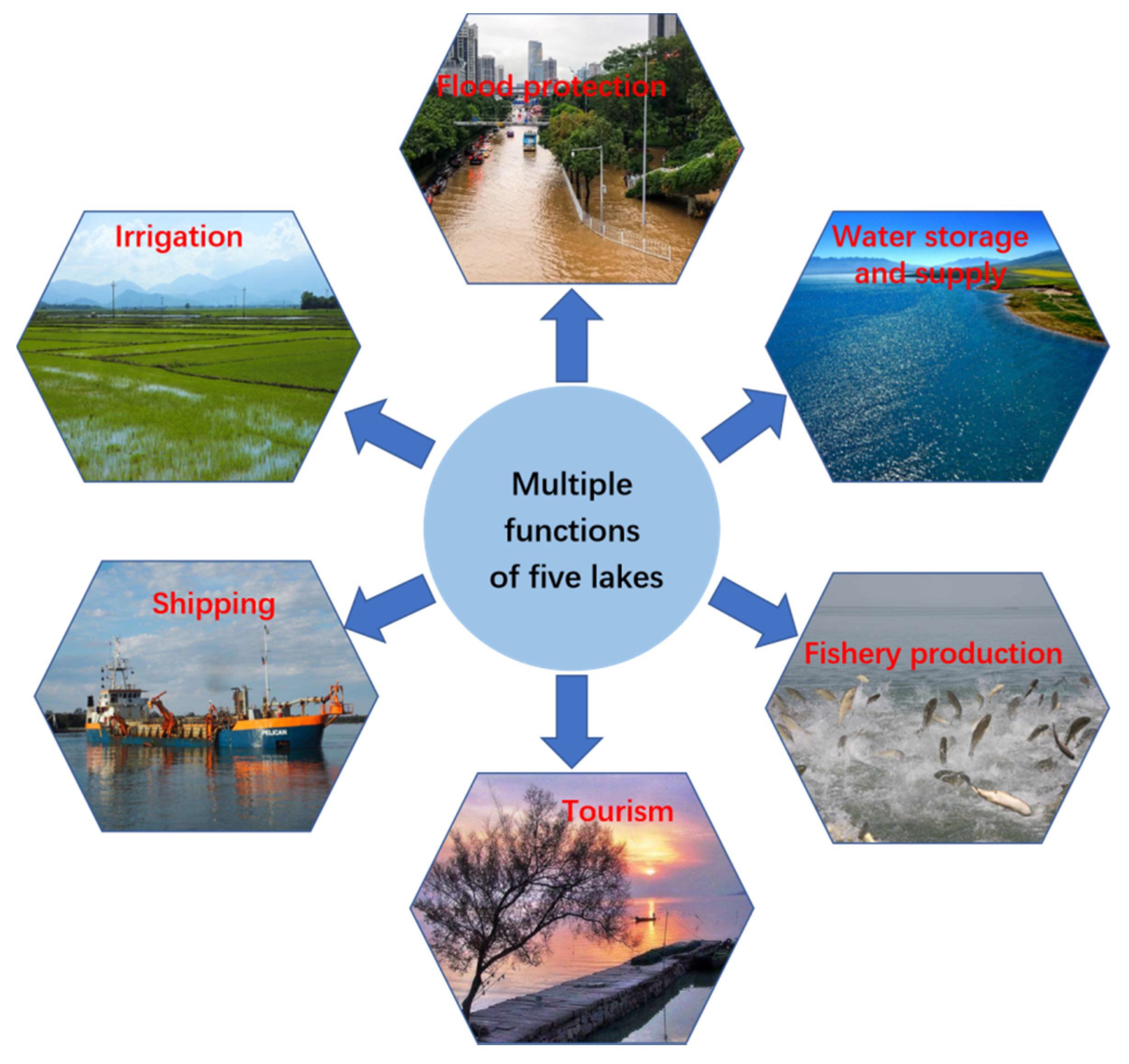

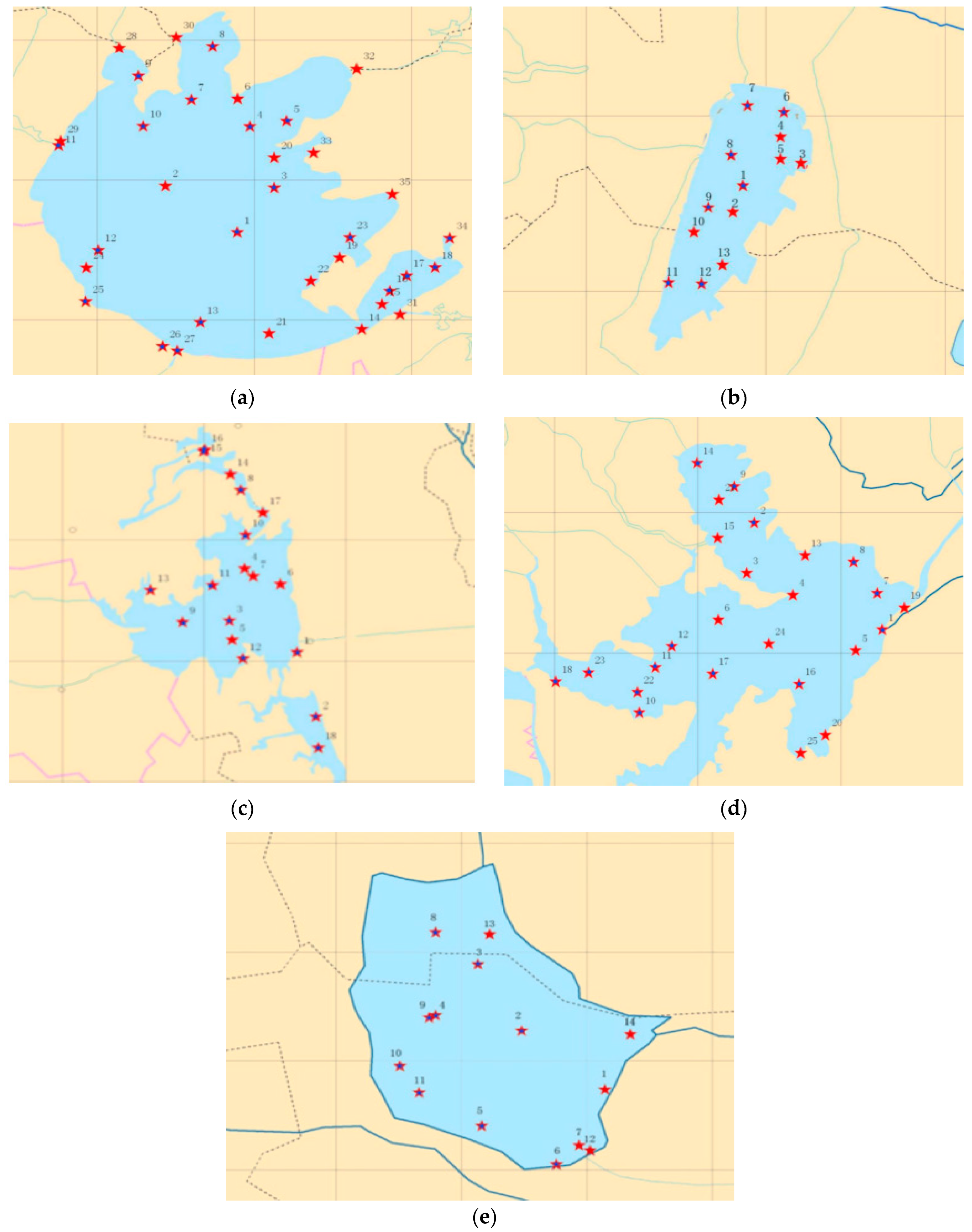
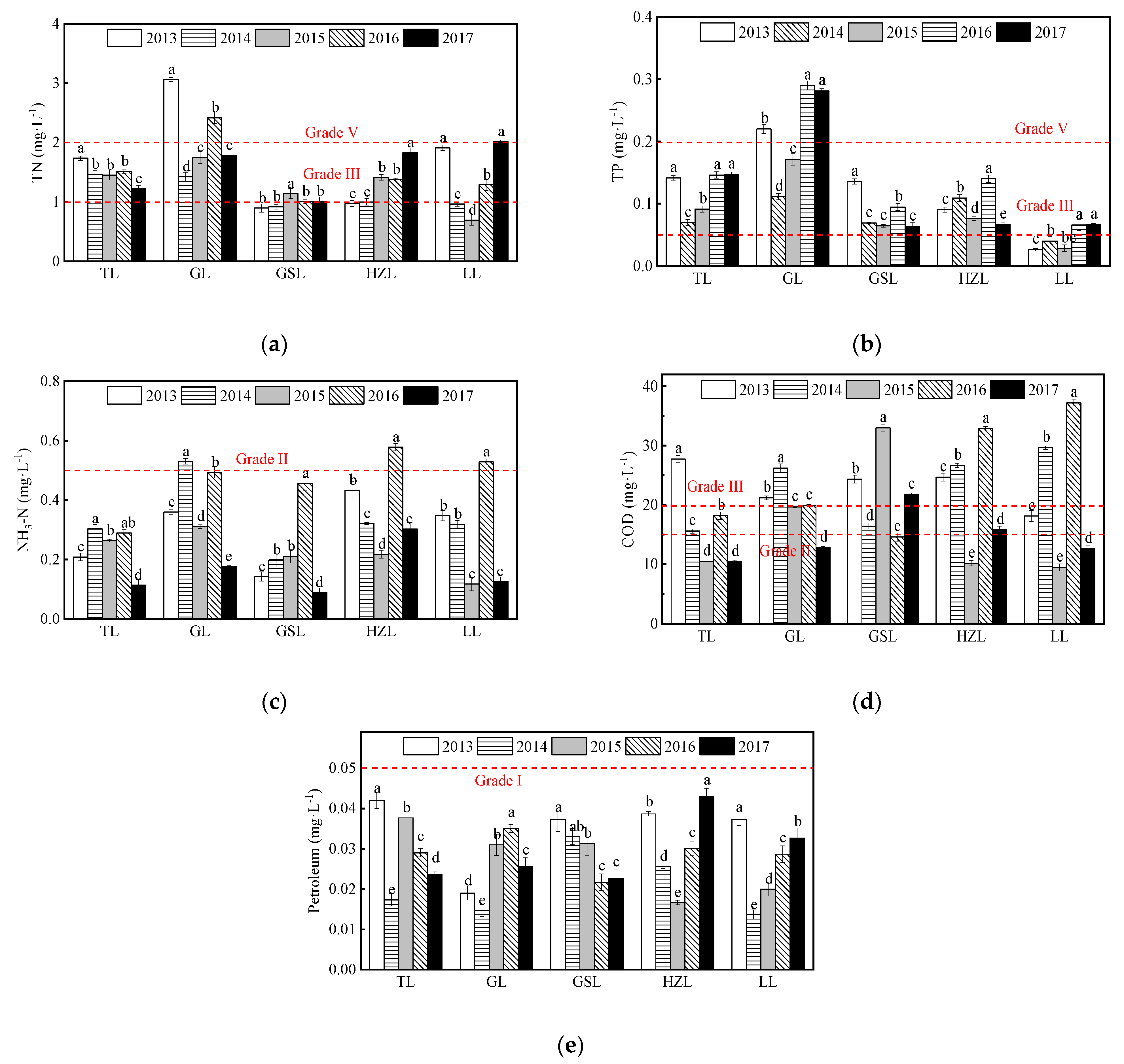


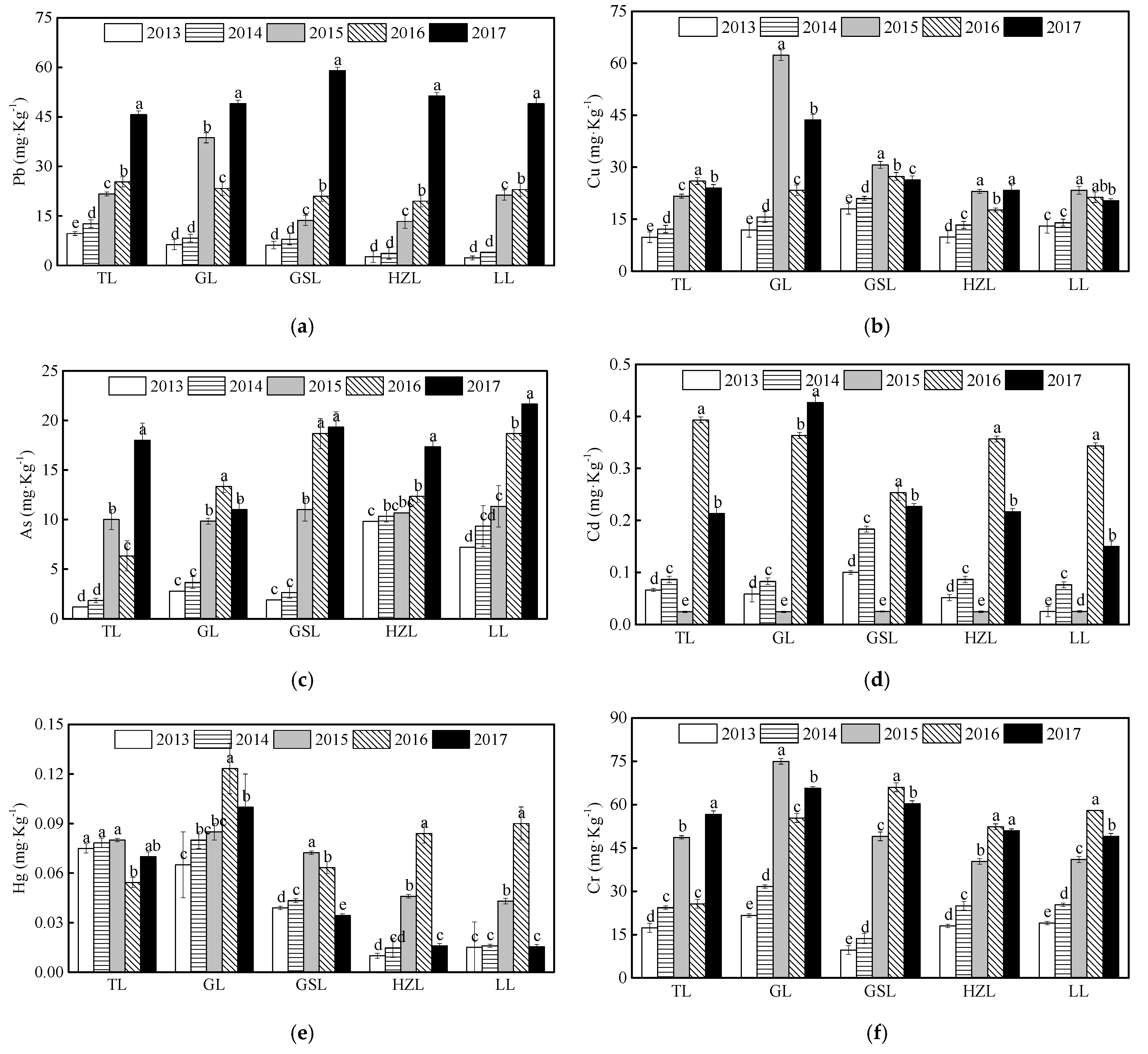
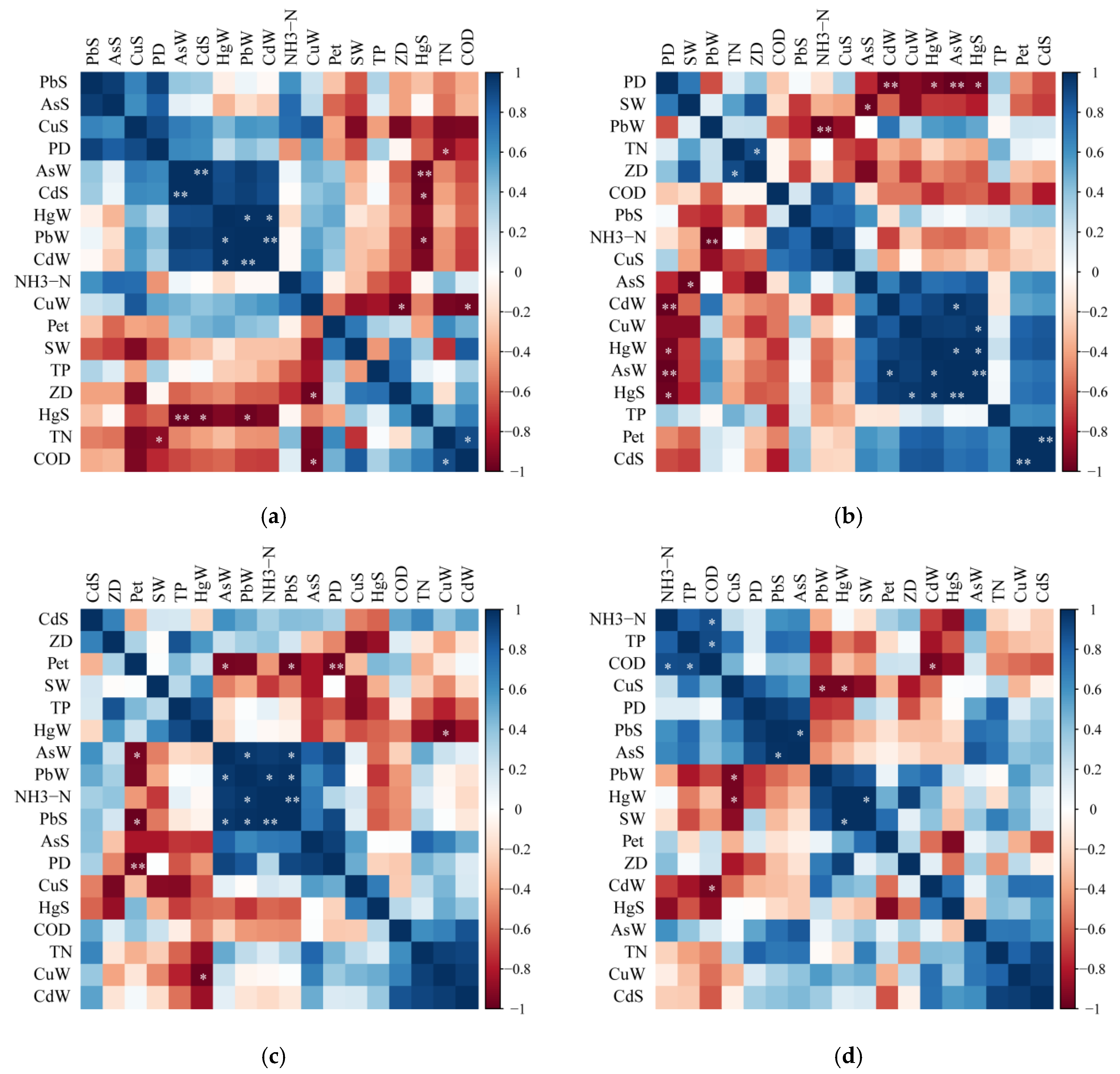
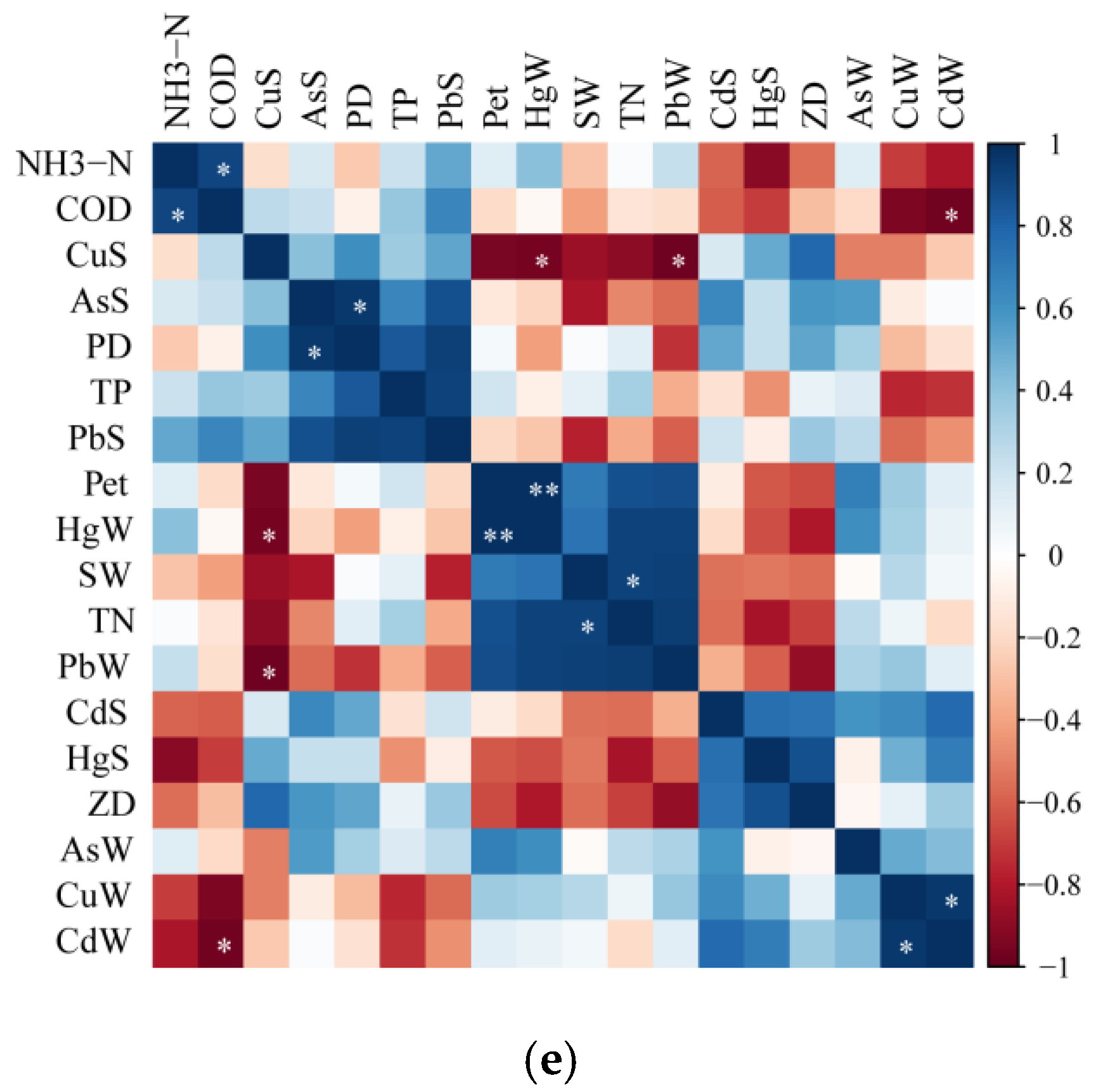


| Lake | Area (km2) | Water Volume (m3) | Average Water Depth (m) | Average Temperature (°C) | Annual Precipitation (mm) | Flood Season |
|---|---|---|---|---|---|---|
| TL | 2338 | 4.4 × 1010 | 1.9 | 16–18 | 1110–1150 | June–September |
| GL | 146 | 0.215 × 1010 | 1.3 | 16 | 1126 | June–September |
| GSL | 960 | (0.096–0.144) × 1010 | 1–1.5 | 14 | 1046 | June–August |
| HZL | 2069 | 3.12 × 1010 | 1.77 | 16.3 | 926 | June–September |
| LL | 296 | 0.27 × 1010 | 3.3 | 13.5 | 800 | July–September |
| TL | GL | GSL | HZL | LL | |
|---|---|---|---|---|---|
| 2013 | 0.75 | 0.78 | 0.82 | 0.87 | 0.76 |
| Moderate | Moderate | Moderate | Moderate | Moderate | |
| 2014 | 0.73 | 0.64 | 0.70 | 0.72 | 0.73 |
| Moderate | Mild | Mild | Moderate | Moderate | |
| 2015 | 0.77 | 0.79 | 0.66 | 0.63 | 0.62 |
| Moderate | Moderate | Mild | Mild | Mild | |
| 2016 | 0.71 | 0.96 | 0.85 | 0.72 | 0.71 |
| Moderate | Moderate | Moderate | Moderate | Moderate | |
| 2017 | 0.69 | 0.75 | 0.68 | 0.77 | 0.76 |
| Mild | Moderate | Mild | Moderate | Moderate |
Publisher’s Note: MDPI stays neutral with regard to jurisdictional claims in published maps and institutional affiliations. |
© 2022 by the authors. Licensee MDPI, Basel, Switzerland. This article is an open access article distributed under the terms and conditions of the Creative Commons Attribution (CC BY) license (https://creativecommons.org/licenses/by/4.0/).
Share and Cite
Chang, Y.; Feng, Z.; Liu, J.; Sun, J.; Sun, L.; Tang, Q.; Yao, D. Trends and Causes of Raw Water Quality Indicators in the Five Most Famous Lakes of Jiangsu Province, China. Int. J. Environ. Res. Public Health 2022, 19, 1580. https://doi.org/10.3390/ijerph19031580
Chang Y, Feng Z, Liu J, Sun J, Sun L, Tang Q, Yao D. Trends and Causes of Raw Water Quality Indicators in the Five Most Famous Lakes of Jiangsu Province, China. International Journal of Environmental Research and Public Health. 2022; 19(3):1580. https://doi.org/10.3390/ijerph19031580
Chicago/Turabian StyleChang, Yajun, Zheyuan Feng, Jixiang Liu, Junfang Sun, Linhe Sun, Qiang Tang, and Dongrui Yao. 2022. "Trends and Causes of Raw Water Quality Indicators in the Five Most Famous Lakes of Jiangsu Province, China" International Journal of Environmental Research and Public Health 19, no. 3: 1580. https://doi.org/10.3390/ijerph19031580
APA StyleChang, Y., Feng, Z., Liu, J., Sun, J., Sun, L., Tang, Q., & Yao, D. (2022). Trends and Causes of Raw Water Quality Indicators in the Five Most Famous Lakes of Jiangsu Province, China. International Journal of Environmental Research and Public Health, 19(3), 1580. https://doi.org/10.3390/ijerph19031580








